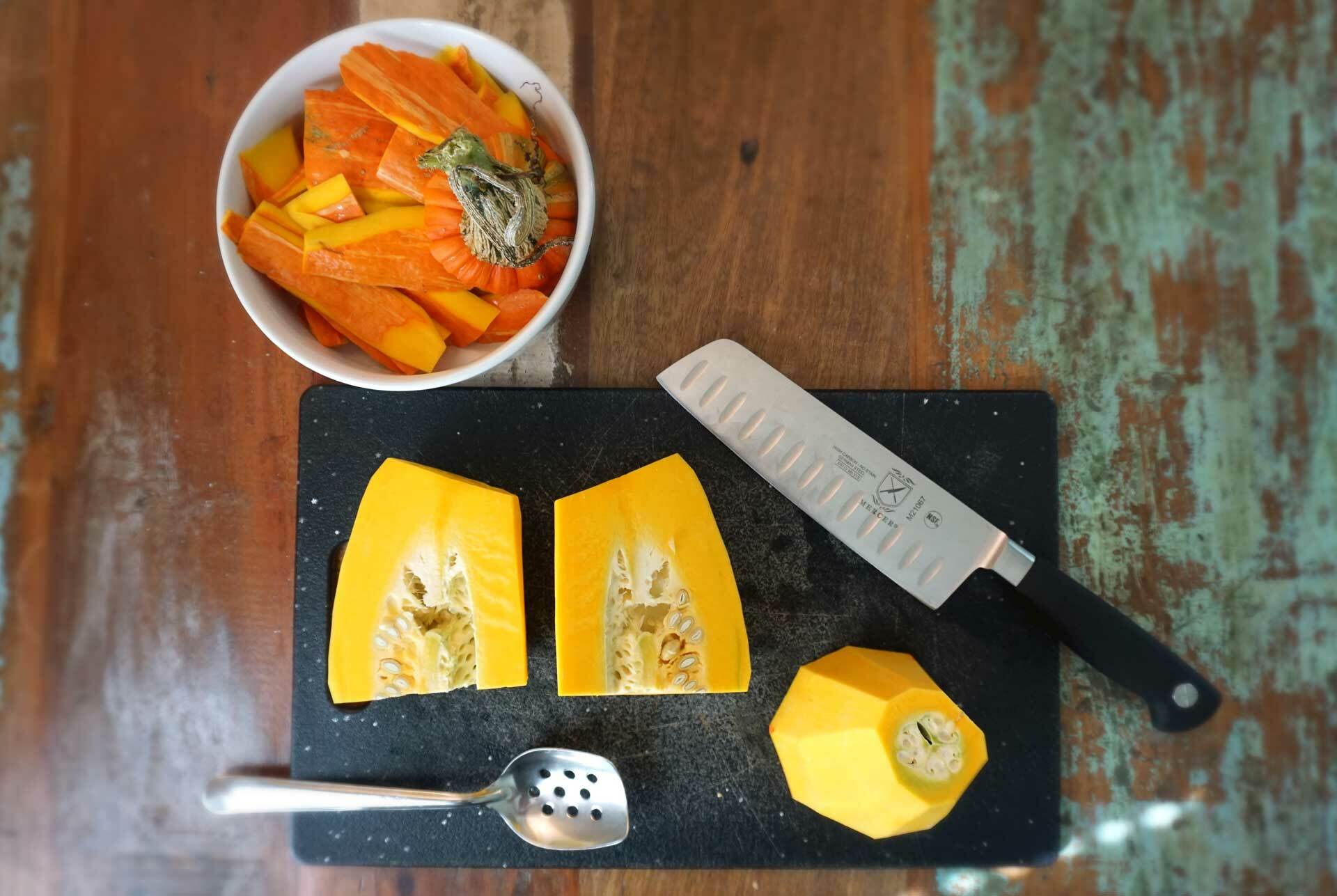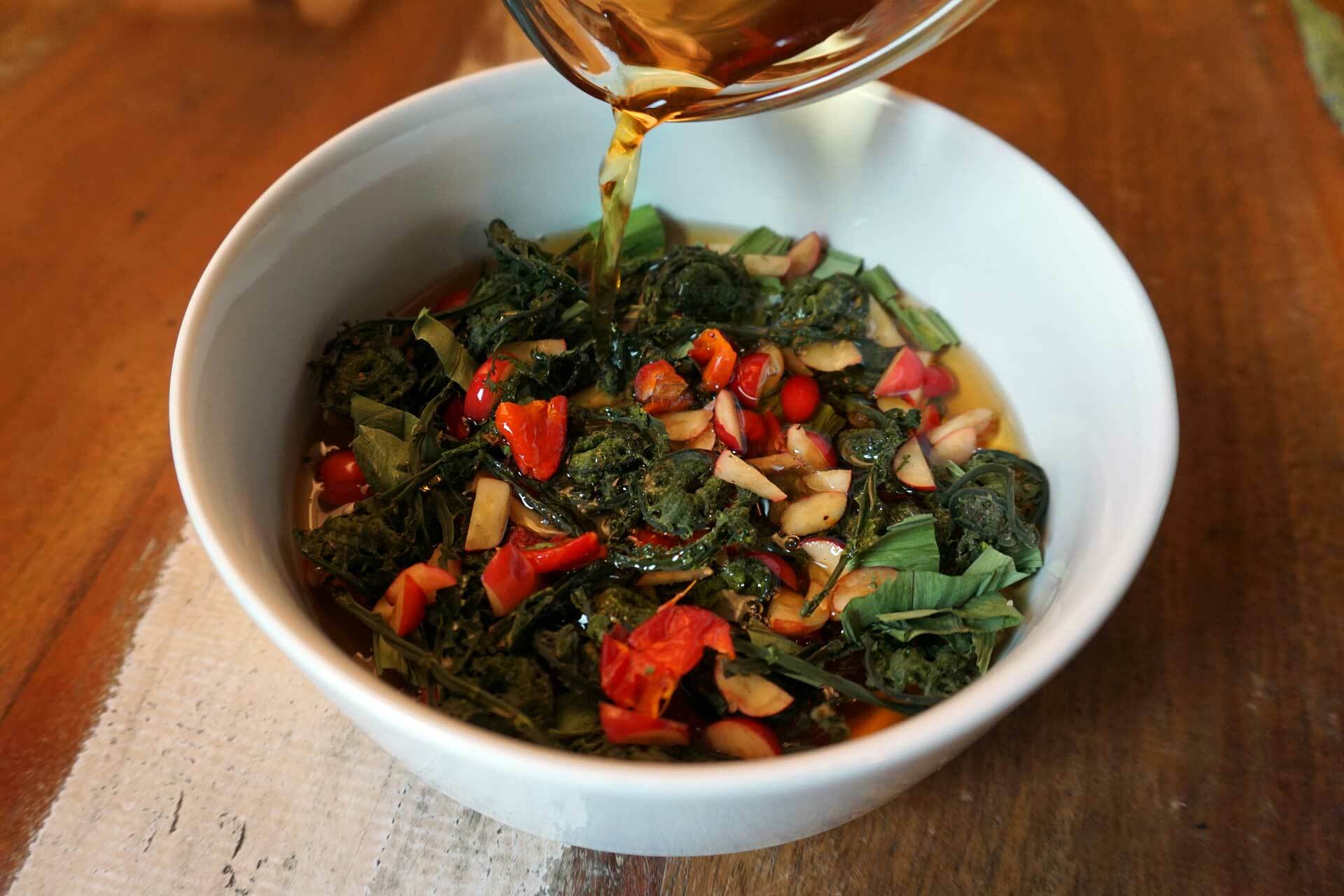Tradition of Squash Pie
Editor’s Note: The opinions expressed in this blog post are solely those of the author.
Last October I was invited to Oahu to cook a 5-course, multi-cultural dinner with chef Ed Kenney, host of PBS show Family Ingredients. Each course turned out to be a surprising and delicious melding of local flavors from Kenney’s region as well as mine (Northern Minnesota).

One of those courses featured a squash pie with a seed crust by me, topped with a salad of ho’i’o (Hawaiian Fern), fresh bamboo shoots, Maui onion and Kukui Nut tossed with citrus and macnut oil by Chef Ed. Now, I cook a lot of food, but that pie was so good it’s been on my mind for nearly a year.
As we enter into the season once again of beautiful squashes, I decided it was finally time to attempt to recreate the balance of flavors the original squash pie dish had but this time utilize all wild and locally sourced ingredients and flavors. The original pie was savory perfection with a touch of sweet, a nice crumbly crust and a fresh citrus and rich nutty crunch…a tough challenge!

If you’re wondering what flavors are local to Minnesota, you’re not alone. The historical and systematic oppression of Indigenous cultures that has taken place in our country means that the foods at the center of our cultures have in some places become shadowy areas of completely lost knowledge in our modern lives. Our foods have a lot to offer and as inhabitants of Turtle Island (North America), it is up to all of us to engage in the responsibilities needed to acknowledge and take care of them.
The Gete-Okosimaan (Ancient Squash) in this recipe came from the hands of youth working in the Babaamaadiziwin Gitigaan (Journey Garden) out of Nahgahchiwanong (Fond du Lac Band of Lake Superior Chippewa) Reservation, about a half hour drive from where I live in Duluth, MN. This squash has a vibrant, orange flesh and is great when simply tossed with a little oil and baked in the oven, as it releases it’s own juicy nectar and then bakes in it to caramelized deliciousness.

Both the original and the re-created pies are gluten free, dairy free, and vegan. The traditional diet of the Anishinaabeg isn’t built on dairy and wheat, and Chef Ed and I had originally decided we wanted to prepare a feast that was brimming with as many traditional flavors as possible, so it just kind of turned out that way.
The crust is a mixture of shelled pumpkin and sunflower seeds blended with a bit of homemade wild rice flour, maple syrup, some wonderful sea salt I was gifted from a friend who gathered it himself during his family’s yearly North Shore salt harvest every year on Oahu, and just a splash of water and oil. It’s a crust that I developed in 2016 when I was working in the Sioux Chef kitchen in Minneapolis, with the help of my friend and mentor Sean Sherman and his sunflower cookie recipe that I was tasked with helping to perfect during my year in the kitchen with him.
Last October in Oahu, wild ferns were in season and so were locally harvested just before our collaborative dinner. This time around, trying to utilize all local flavors in October in Minnesota means all of my fern gathering has come and gone and my fern friends have been in and out of the dehydrator for some months now. For this recipe, I had to figure out a way to rehydrate the fiddleheads with as much flavor as possible.

I decided to go foraging for sumac berries, as they were nice and red just when I needed them to be. When I got home, I packed the berries into a glass jar and filled it with water and left it to soak overnight. I new that in the morning I would have a citrusy liquid I could add a little maple syrup and salt to and rehydrate my fiddleheads with. To this I added some chopped and dehydrated wild leek greens I had gathered the same time as the fiddleheads, in late spring earlier this year. I was thinking this would cover the onion and citrus of the original recipe. I threw some crabapple into the mix for good measure and crunch.
The pie turned out delicious. The fiddleheads rehydrated into a nice, firm-ish texture with the freshness and citrus of the crabapple and sumac adding a locally-derived source of brightness to the dish while the leeks rounded it out with their own wild and savory, onion appeal.
Recipe: Squash Pie

Ingredients
Crust:
- 1 cup shelled pumpkin seeds
- 1 cup shelled sunflower seeds
- ½ cup broken puffed wild rice
- 1 tsp. sea salt
- 2 tsp. pure maple syrup
- ½ cup water
- extra seeds for pushing into the formed crust
Pie Filling:
- 2 small gete-okosimaan (*Use Butternut Squash as a substitute)
- 2 T oil + 2 tsp.
- 4 tsp. pure maple syrup
- ½ tsp. salt
Fiddlehead Salad:
- About 3 handfuls of fresh sumac berries (*Use fresh cranberries as a substitute)
- 24 dehydrated (or fresh!) wild edible fiddle head ferns. (NOTE: Edible fiddleheads vary with climate and ecosystem. Here in Minnesota, I collect Ostrich Fern fiddleheads. A fiddlehead is a general term for the unfurled leaf, when it’s still all cooled up and resembles the scroll pegheads on some stringed instruments. It is a term that can apply to any species, so check which species are edible in your region. If not available, you can use 2 stalks of asparagus, chopped, as a substitute.)
- 8 wild rosehips, slightly dehydrated and seeded
- 1 dozen small crabapples, cored and chopped
- 8 dehydrated wild leek greens, chopped (*Use onion cut into 1/8” half-moon strips as a substitute)
- 4 T real maple syrup
- ½ tsp. sea salt
- 1 T oil
Directions
- Crust: Process seeds in a food processor until the mixture is fine enough that it starts clumping to itself. Add the broken puffed wild rice. (To make puffed wild rice, simply heat a dry pan over medium heat and add wild harvested wild rice to the hot pan about 2 T at a time. It will puff quickly, so shake the pan a lot and have something to pour the rice in quickly nearby. Break the puffed rice in a food processor for about 20-30 seconds.) Add the salt, maple syrup, and water. Blend until the batter is equally moist. Batter will be formable. Push into an ungreased pie pan and bake for 15 minutes at 350F and check for browning. If the bottom isn’t browned at all yet, turn the oven down to 325F and watch the crust for light, even browning. Remove from oven and cover to cool until bottom of pan is cool enough to cool in fridge. Take crust out of fridge at least a half hour before adding pie filling.
- Cut the ends off of 2 small gete-okosimaan. Cut squash in half across the round-way. Peel each half then cut squash in half again, this time from top to bottom. Remove the seeds and cut squash into about 1inch cubes. Toss with oil.
- Cook at 350F for 15 minutes. Check for browning and softness. Turn pan if needed and cook for another 15 minutes. Squash should be starting to brown and will be soft when poked. Remove from oven and cool to room temperature.
- Blend squash in a food processor along with maple syrup, salt, and oil. Spoon into crust and smooth the top out. Bake at 350F for 30 minutes. Pie should feel slightly firm to the touch. Crust should be browning and smell delicious! Cool to room temperature before cutting.
- *Pack fresh sumac berries in a 16 ounce canning jar, fill with water and soak overnight.*
- In the morning, strain out the berry solids through a cotton cloth and to the liquid (should be almost 1.5 cups) add maple syrup, oil, salt, ferns, rosehips, and crabapples. Let sit in the fridge for at least 2-3 hours. Add leeks, stir, and sit for another 10 minutes. Top pie and enjoy!
Photos and essay produced by PBS member station KQED, in collaboration with PBS Food. See the full photo gallery from this essay and find more recipes at the PBS Food Native America collection.



